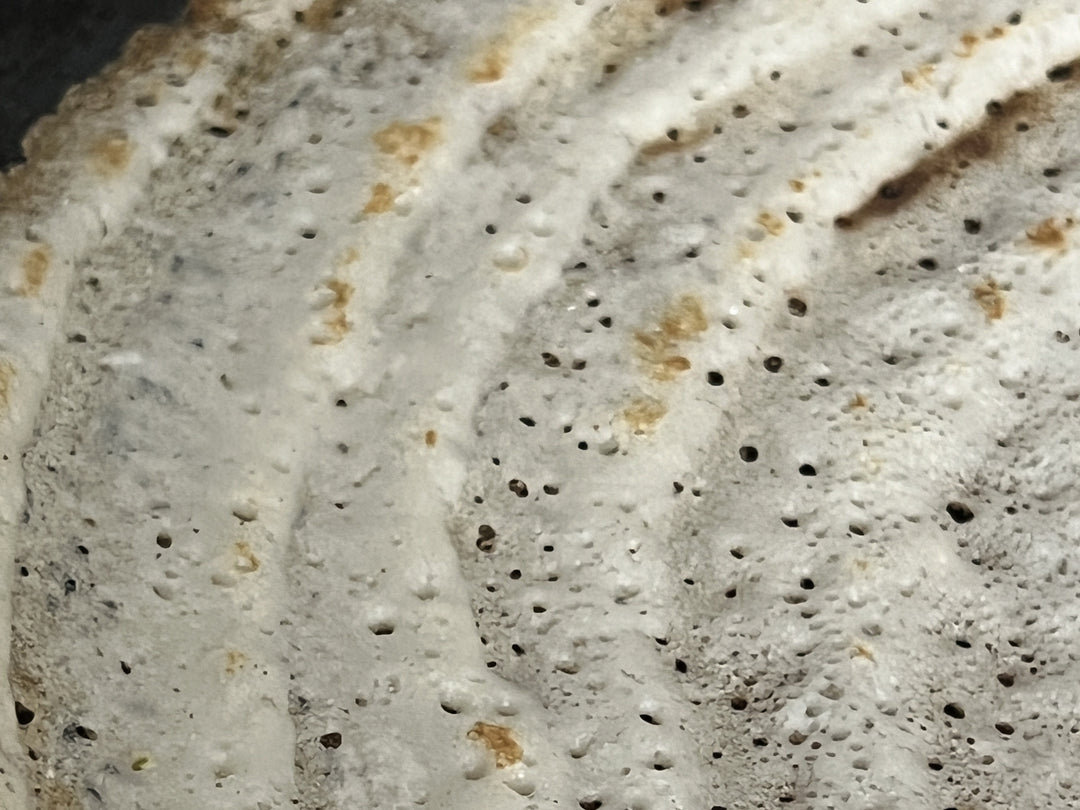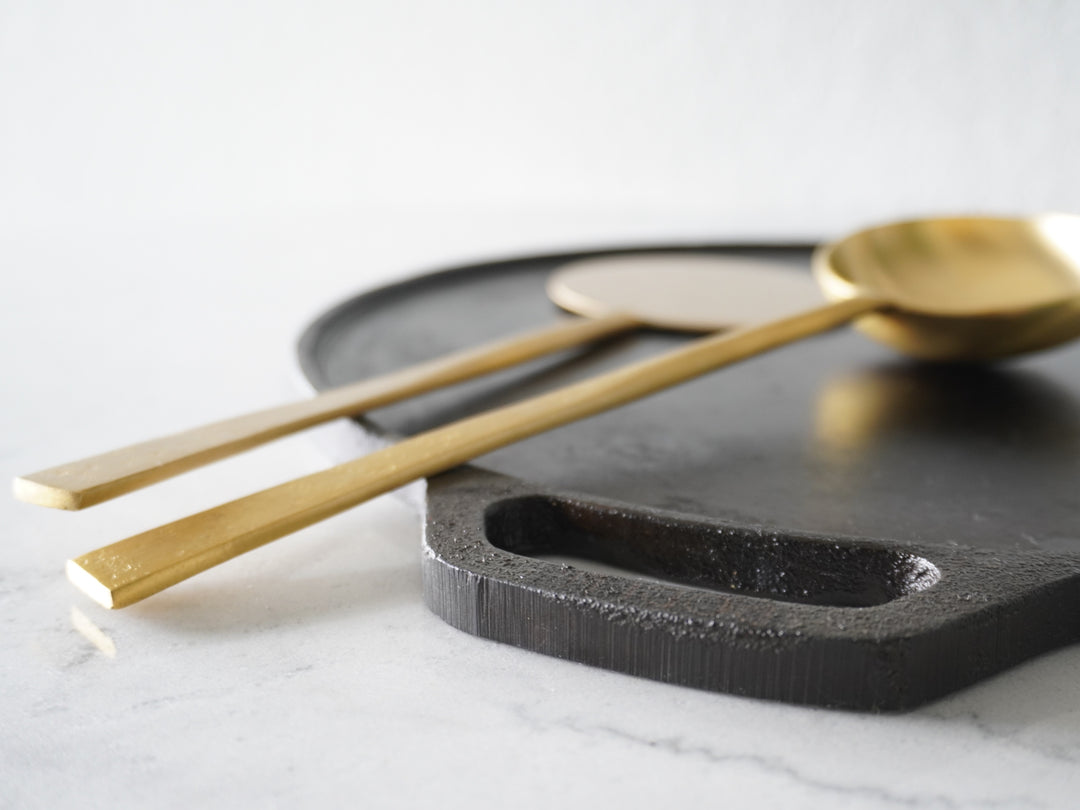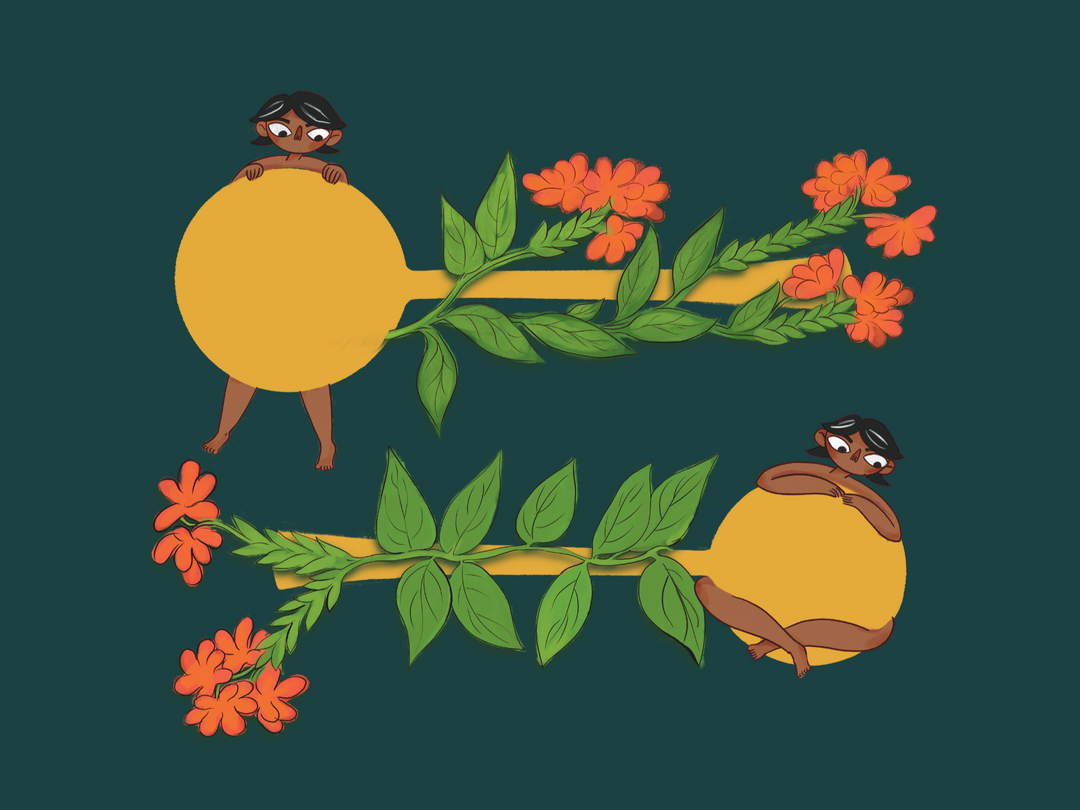Questions about the trio
- It's the combination of all the tools that makes it an excellent addition to your kitchen! The utensils have the perfect heft and beauty to bring joy to your podi-dosa parties!
- Our utensils went through 10 iterations and have been perfected with lots of testing across India and US. We got a lot of "where can I buy these?" during testing. So we're damn proud of what we've designed with the highest quality food-grade brass!
- Now about the pan - the 12” flat cooking surface of the pan is just right for making perfectly sized dosas! A thin lip all around the edge prevents things from sliding off the pan, while allowing you to flip even the biggest dosas with ease! (Incidentally, it’s also the perfect size for crisping up pizza crusts or reheating pizzas, making the crispiest of sammiches, and a 12" quesadilla!)
- Ergonomic handles on both sides of the pan allow you to carry the pan with ease.
- We have painstakingly triple-seasoned the pan with organic grapeseed oil - the pan has a texture somewhere between the rough surfaces you see on cheaper pans and the highly smooth surfaces you see on polished pans. This is intentional! This kind of surface is smooth enough to be very non-stick (and good lookin!), but rough enough to hold the seasoning for a long time.
- We picked a pan that's an optimal balance between thickness and weight. It’s the perfect thickness for a delectably crispy crust but not so thick as to be heavy and unwieldy.
- Brass and cast iron are excellent heirlooms to pass on to the next generation. They get better with time!
- We have also included some PODI samples, one perfectly portioned rice-millet-lentil mix (serves 4) and a dosa masterclass to get you started on your dosa journey - nothing quite beats that :)
- The trio purchases comes with a 12" cast iron pan, 2 hand forged brass utensils, a live dosa masterclass (+recording), PODI samples, a pre-portioned, whole-grain mix to get you started on your first fermented dosa batter.
- All of this is priced at $295 (and waitlist subscribers get 10% off during the 48hr early access period)
- Shop Pay feature allows you to purchase this in four 0% installments
Questions about Cast Iron
- Iron-carbon alloy- that is iron with more than 2% carbon in it. Not only does the carbon make it easier to cast (put in a mold) but it makes it virtually indestructible! It can handle incredibly high temperatures and rough handling without any issues.
- The cast iron is poured into a sand mold (a very environmentally friendly process) and heated to make these beauties.
- The raw pan is not going to behave very well until the cast iron is “seasoned” with oil (this is what gives it that dark glossy finish!).
- Cast iron can go anywhere - stove or inside your oven. Just don’t put it into your dishwasher!
- Seasoning is the process by which a thin layer of oil is applied to the pan and then heated at a very high temperature for a long period of time.
- The oil turns into a carbon polymer that bonds with the surface of the pan and turns into a healthy non-stick alternative!
- By repeating the seasoning process three times we build these polymer layers gradually and this makes the pan non-stick from the very first use! It also makes the layers relatively long-wearing and the non-stick effect won’t wear off very soon.
- We’ve used cold-pressed organic grapeseed oil to season your pan.
- However no seasoning is permanent! By using the pan often, you keep rebuilding the seasoning layers every time you add oil and heat the pan. This is why used cast iron pans passed down over generations hold so much value! They actually get even better over time! Can you think of anything else that gets better with every use?
- Cast iron retains heat more than any other material - this means that when you pour the dosa batter, it doesn’t cool down and enables a perfectly crisp dosa to form.
- Cast iron is a healthier choice! Teflon coatings of non-stick pans start leaching into your food after some time. From a well-seasoned cast iron pan, very little iron leaches into your cooking and if it does, it just adds to your dietary iron requirement.
- Its production is environment friendly.
- Well-seasoned cast iron behaves just like non-stick pans.
- It’s the closest to the large commercial iron griddles on which dosas are made commercially.
Yes! absolutely. Cast iron works on induction, electric and gas stoves.
- Not if you have all the inside info! The secret is that you do most of the work by gently scraping off all residue from the pan.
- If necessary, you can run it under water with a gentle scrub with some salt or any non-metal scouring pad.
- You might have read elsewhere that soap is a no-no, but it’s actually ok to use as most soaps nowadays are a lot less harsh than the lye-based soaps used previously!
- If you’ve used water, you’ll want to dry your pan thoroughly and if you want to be extra thorough, heat it on medium heat to get rid of any remaining moisture.
- If you’ve used soap, you’ll want to first dry your pan, then use a tiny amount of oil to coat the inside again. To prevent the oil from going rancid, reheat the pan to allow the oil to carbonize/polymerize with the pan. If you’re using your pan regularly, once a week of this is more than enough!
- Our pan is reserved for all the dry stuff- so we don’t do anything more than a few gentle scrapes!
- This might scare you into thinking it’s unhygienic- is not! As long as the pan is dry, microbes won’t grow, and heating the pan will get rid of any moisture.
- No matter what, never soak a cast iron pan! This won’t ruin it, but the moisture will break down the layers of seasoning you’d have built with so much love!
- Rest assured that when you purchase your pan from us, we’ve done much of the heavy lifting for you, and your pan is ready to use.
- Regular use of your pan with oil will automatically rebuild the seasoning layers.
- If you’ve accidentally soaked your pan, or stored a pan while it’s still damp, you may find that food starts to stick when you cook. Or you may even see some rust on your pan. If this happens, don’t worry! Re-seasoning a pan is easier than you think it is and just requires some patience.
- Give your pan a good scrub with soap and water
- Dry the pan thoroughly by heating it on medium.
- Use any neutral oil to coat all the surfaces of the pan.
- Next, use a paper towel to remove all excess oil.You want a very thin layer of oil, that’s perfect for polymerization. You don’t want a thick layer of oil anywhere that will refuse to polymerize. Excess oil will leave your pan sticky.
- Turn your oven to high heat (between 450-500 F degrees for about an hour) which enables the oil to go past its smoking point and polymerize. This process might be a little smelly as the oil goes past its smoking point. So, have an exhaust fan on!
- You can cook practically anything with cast iron!
- Highly acidic foods can affect the seasoning layer though, so it’s better not to use too much of things like tomato sauce or vinegars. A little bit is okay, though!
- We’re glad you asked! We’ve made THE MOST wonderfully crispy toast, pizza, crepes, okonomiyaki, sandwiches, quesadillas and even cookies.
- It’s perfect for anything you want to make crispy or get a nice brown crust on!
- And here’s another game-changing secret for you - its size makes it the absolute best at reheating pizzas! no more soggy pizza leftovers.
- It’s almost impossible to ruin a cast iron pan!
- That said, it does require a bit of patience as do all good things in life. What makes cast iron so perfect to get brown crusts and crisping is that it holds on to heat very well. However, on the flip side, it does take a bit longer to get the pan hot. Avoid trying to speed up this process by putting a cold pan on high heat- especially if your gas stove is electric! Sudden changes in temperature and uneven heating (using a coil-type or electric burner that is too small), if done over and over, may warp the pan.
Questions about Brass Utensils
- Brass can be cast, forged, spun or stamped. Cast and forged brass are expensive. With these two forms - heat is applied to brass to mold it into shape.
- These utensils are cast - this means, molten brass is poured into a cast or and then scuffed to give them their beautiful shape. Plated brass is the cheapest form of brass, since plated brass is thinned by a machine into sheets and pressed into shapes.
- Usually the thicker the walls of brass, the more expensive it tends to be, as thicker articles tend to be handmade.
Each utensil is hand-forged by artisans who have been doing this work for generations, in Moradabad (also called the Brass City of India). They are made by hand, the marks on each utensil are unique. They are testament to the workmanship of these artisans that the Fleck team has been working with for generations.
- For the aesthetic! Food grade brass is more expensive as a metal than food grade stainless steel. Food grade brass is safe and has a beautiful heft and sheen that makes using these utensils a total joy!
- Here’s a pic of Claude Monet’s kitchen filled with copper and brass cooking utensils - he had a great passion for gardens, cooking and entertaining people at his home in Giverny.
Brass that is not magnetic is solid brass. Good quality, expensive brass has a golden sheen. A more silvery sheen means the brass is cheaper.
Brass is an alloy of copper and zinc. Patina is a natural tarnish that forms on top of brass with exposure to several things. (there are many patina connoisseurs around the world, who deliberately form a patina to create unique aged beauty on any brass items!)
- A quick lesson on pH: pH 0 to 4 are highly acidic, pH 4 to 7 are mildly acidic, pH 7 is neutral, pH over 7 are alkaline.
- These brass utensils are made to be used with all alkaline, neutral, and mildly acidic substances, like dosa batter (pH 4-5) and most vegetables and fruits.
- It's worth noting that brass is reactive to highly acidic ingredients like lemon (pH of 2-3) or vinegar (pH of 2). With prolonged exposure to acidic substances, utensils will discolor with time.
- pH of salt is 7 - it is neutral, like water. So salt does not react with brass.
Vinegar can dull brass if left on the surface for too long or if the brass is scrubbed too hard with vinegar. Use vinegar sparingly when cleaning brass, and always use it mixed with baking soda and salt, or water to minimize the abrasiveness.
If you want to clean the patina, we recommend scrubbing with a mix of flour, salt and vinegar, or lemon juice, or even tamarind pulp juice cleans up this patina. Use a gentle cloth or toothbrush to clean, avoid using metal or harsh scrubs.
- Do not wash your brass utensils in the dishwasher. We recommend hand washing immediately after use. You can use soap, but even just a simple wash and wipe is enough.
- Watermarks that aren’t wiped away develop into a patina over time.
- But if you’d like to avoid patina, you can wipe your utensils dry and it won’t leave any watermarks.
- Modern day soaps are fairly gentle to use. So you can use any household soap.
- Don’t put your utensils in the dishwasher.
Questions about Dosa Masterclass
- The science, the art of making dosa batter from scratch.
- Tips and tricks to make dosa batter even in peak Chicago winter.
- Chutney template recipes to go with dosas
- Types of dosas and links to easy follow-along recipes
- We will give you 4 scheduled times to choose from.
- Each masterclass will be held live, with a maximum of 25 participants. We want to make sure we can troubleshoot issues during the masterclass :)
- We anticipate each class to be 2 hours long.
- You will receive a recording of the class, in case you miss it or want to refer to it later.
- You will also receive recipes/info from the class by email after the class!
Shipping and Returns
We're currently only shipping across continental US and shipping is complimentary with purchase.
Returns are available within 14 days of product delivery. You must provide a valid reason for return. We are happy to provide full returns for damaged products. Otherwise, there is a $50 restocking fee for all returns made during the 14 day period (from product delivery). Beyond the 14 day period from delivery of product, unfortunately returns will not be entertained.




